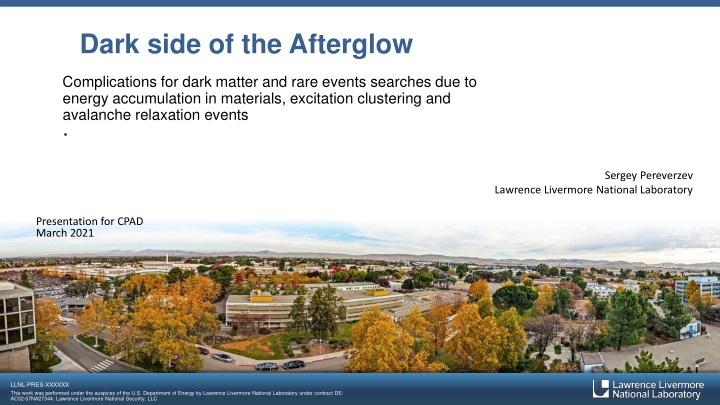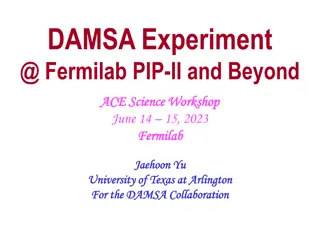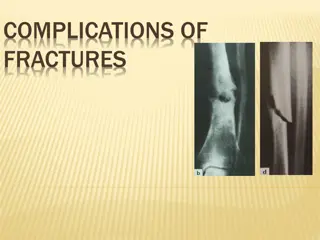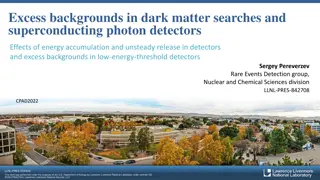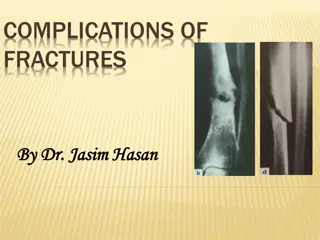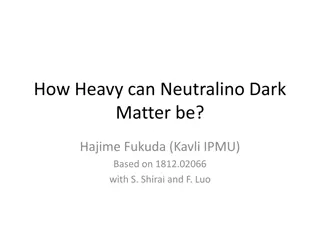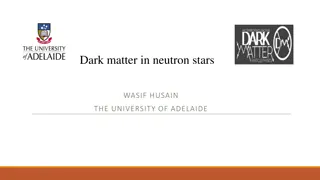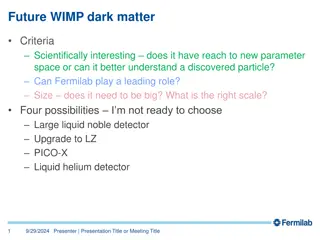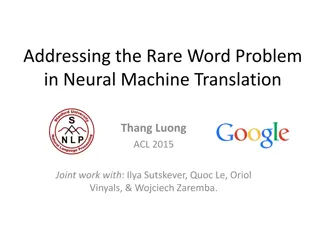Dark Side of the Afterglow: Complications in Dark Matter and Rare Events Searches
Exploring the challenges in detecting dark matter and rare events due to energy accumulation, excitation clustering, and avalanche relaxation events. Discusses issues such as low-energy background, ionization load on detectors, dual-phase detectors, universal scenarios of energy accumulation, and energy storage in materials post-irradiation. The presentation sheds light on self-organized criticality, thermally stimulated luminescence, and various phenomena related to energy storage and emission in different materials.
Uploaded on Sep 07, 2024 | 4 Views
Download Presentation

Please find below an Image/Link to download the presentation.
The content on the website is provided AS IS for your information and personal use only. It may not be sold, licensed, or shared on other websites without obtaining consent from the author.If you encounter any issues during the download, it is possible that the publisher has removed the file from their server.
You are allowed to download the files provided on this website for personal or commercial use, subject to the condition that they are used lawfully. All files are the property of their respective owners.
The content on the website is provided AS IS for your information and personal use only. It may not be sold, licensed, or shared on other websites without obtaining consent from the author.
E N D
Presentation Transcript
Dark side of the Afterglow Complications for dark matter and rare events searches due to energy accumulation in materials, excitation clustering and avalanche relaxation events . Sergey Pereverzev Lawrence Livermore National Laboratory Presentation for CPAD March 2021 LLNL-PRES-XXXXXX This work was performed under the auspices of the U.S. Department of Energy by Lawrence Livermore National Laboratory under contract DE- AC52-07NA27344. Lawrence Livermore National Security, LLC
Low energy (few photons or electrons events ) background Largest at single electron/single photon with tail to multiple electron/photon events Few electron peak rising with ionization load on detector Xe 100 DAMA- LIBRA NAI(Tl) And with impurities concentration(dual-phase detectors) Multiple electrons events are more likely than random coincidence single electron events (something correlate electron emission) (dual- phase detectors) SENSEI thick silicon CCD) Dark Side 50 (Ar detector) 2 LLNL-PRES-xxxxxx
Universal scenario: energy accumulation and avalanche relaxations Self-organized criticality Appears in computer simulation of large ensembles of interacting particles Classical example - avalanches on sand pile with material added to the top Polynomial spectrum of events Probability of larger relaxation event decreasing slower than exponentially Large avalanches can be suppressed by reinforcing relaxation on small scale Per Back, Chao Tang and Kurt Wiesenfeld ( 1991 paper) Self-Organized Criticality Example - sand pile on vibrating plate 3 LLNL-PRES-xxxxxx
Energy storage in materials after irradiation, breakdown, etc. Solid materials (and films on metal) Thermally stimulated luminescence, exaelectron emission, conductivity (up to 15% of energy stored) - Pairs of trapped ions Not widely known examples of TSL: solid Xe and NaI Gases, liquids Afterglow Gas breakdown memory - Chemical radicals, triplets Surfaces and interfaces Photon & electron emission after deformation Vacuum breakdown memory (electrodes surface) After-pulsing in PMT long list of effects and mechanisms God invented crystals, devil- surfaces TSL in NaI(Tl) (1985) (All Alkali-metal halides) TSL, TSEE in solid Xe, Ar; relations to defects (annealing) 4 LLNL-PRES-xxxxxx
Avalanche relaxation events Very few clean SOC examples (crack formation, vortices in superconductor) Solids where TSL, TSEE or TSC are present may demonstrate SOC-like effects- simultaneous (correlated) emission of few photons or electrons But: Clustering of defects, impurities, excitations, ion pairs , etc., provide conditions for avalanches Diffusion and self-trapping at defects & boundaries provide pass way for cluster formation n solids Saint-Gobain technical note on NaI(Tl) With mild UV exposure, several pulses per second can be seen in the 6-10 keV region of a spectrum. If the crystal is stored in a dark area, this mild UV exposure will eventually disappear, although it may take from several hours to several days for the effects to stop. Clusters, molecular aggregates formation known for gases & liquids 5 LLNL-PRES-xxxxxx
Avalanche relaxation evens in NaI(Tl) scintillator David Nygren (arXiv 1102.0815): DAMA-LIBRA low energy background modulation can be caused by seasonal fluctuations of the flux of muons -energy pumping in SOC- type process Suppression of SOC-type dynamics by environmental triggers: pressure oscillation (sandstorms yearly pattern), solar neutrino flux modulation a-la shaking sand pile. Suppression of TSL by IR/ red light in alkali-metal halides known: Irradiation with red/ IR light should prevent energy accumulation and suppress modulation effects from SOC-type effects while not affecting direct dark matter particles signals. 6 LLNL-PRES-xxxxxx
Xe (Ar) detectors trace impurities photo-synthesis reactors Liquid Xe replacement and photochemical synthesis media for functional group Impurities in liquid gases can make molecular aggregates and radicals that are not existing in gas phase. Molecules which will react in exothermal reaction in gas can form a low energy hydrogen bond - form a stable complex with excessive chemical energy* Our hypothesis: in liquid Xe (Ar) impurities and radicals can form metastable clusters with chemical energyto release several electrons and photons (nano-explosives). *) Spectroscopy of molecules and molecular complexes dissolved in liquid gases: Structure and reactivity , published in Russian Chemical Reviews, 57 (8), 1988 7 LLNL-PRES-xxxxxx
Possibilities for Avalanche relaxation in dual-phase Xe and Ar detectors on surfaces and in bulk liquid Surfaces and interfaces Physiosorbed Solid Xe/ Ar films on Electrodes (TSEE and TSL inbuild in detector) Metal surfaces Accumulation of positive ions on electrodes* More on bulk liquid processes: Charged clusters and molecular ions (+ and -) produce free electron while slowly drifting along field lines ( ~1000 times slower than electrons) origin of position and time correlated (with true ionization events) electron emission events Impurities in Bulk liquid Formation of chemical radicals by primary particles, UV Formation of charged clusters with radicals** We posit formation of multi-radical clusters with large chemical energy- nano-explosives Chemical ionization (reactions of ions and radicals)** After ions reach electrodes, neutral radicals and radical clusters still producing not-correlated electron emission events Possible test: Illuminating drift volume with sparking UV light and counting multi-electron events delayed (>~15 ms drift time) after ionization events and sparks can reveal presence of energetic clusters Drifting Xe(Ar) ions get electrons from impurities** Only Low ionization potential ions reach cathode* *) removing impurities may lead to surface electron emission **)processes used in API-mass spectrometers with ppt resolution 8 LLNL-PRES-xxxxxx
Search for avalanche processes with small Xe detector Search for surface SOC-type effects with strong AC surface field Search for bulk liquid effects with Xe flush quartz lamp Split HV cable inside the xenon vessel, apply AC signal - AC signal can come from transformer or appropriate power supply - Will most likely be a custom job - Have an electrical engineer do the design - Can test in small detectors via stability at higher potentials - Can test in full-scale detectors by (hopefully) enhanced electrostatic stability - Related signal: shorter time scale for e- trains Currently installed in collimator Grid A lead Experiments in progress AC power supply or transformer Grid B lead HV 14 AC voltage (2kV, 3MHz) in between grid wires spaced by 1 mm does not result in significant decrease of multi-electron emission events- solid physiosorbed Xe layers on wires are not the dominant source of avalanche relaxation events / forced ion recombination not effective 9 LLNL-PRES-xxxxxx
Dark matter search and detector non-equilibrium thermodynamics By expanding phase space where Dark Matter Particles existence are excluded, In systems under energy flow many things are happening: Formation of dissipative structures we are exploring larger space where non-equilibrium thermodynamics effects can be present another modern concept- chemical reactions networks Possible synthesis of nano-explosives cascade in system under energy flow would be an example of emerging complexity &chemical reactions networks Emerging of order out of chaos Ilya Prigogine (left) Noble Price 1977 Dissipative structures, irreversibility, complexity, order out of chaos, etc. Emerging of complexity Radio-chemical turbulence cascade? 10 LLNL-PRES-xxxxxx
Disclaimer This document was prepared as an account of work sponsored by an agency of the United States government. Neither the United States government nor Lawrence Livermore National Security, LLC, nor any of their employees makes any warranty, expressed or implied, or assumes any legal liability or responsibility for the accuracy, completeness, or usefulness of any information, apparatus, product, or process disclosed, or represents that its use would not infringe privately owned rights. Reference herein to any specific commercial product, process, or service by trade name, trademark, manufacturer, or otherwise does not necessarily constitute or imply its endorsement, recommendation, or favoring by the United States government or Lawrence Livermore National Security, LLC. The views and opinions of authors expressed herein do not necessarily state or reflect those of the United States government or Lawrence Livermore National Security, LLC, and shall not be used for advertising or product endorsement purposes.
Possible universal scenario for background generation Content Similarities in Low energy background- few electrons/ few photons range Possible common scenario Energy accumulation in materials (examples in solids, gases and liquids, boundaries) Avalanche relaxation (examples; role of clustering) Case studies: NaI(Tl) (DAMA-LIBRA) Dual-phase Xe and Ar detectors Experimental searches for possible avalanche relaxation events in Xe detector On a larger scale - relations to non-equilibrium thermodynamics Summary box has a full-width bleed. Delete if not needed. of What are the relative values of our investments? (Discussion) 12 LLNL-PRES-xxxxxx
Delayed electron emission in dual-phase Xe and Ar detectors Energy or charges accumulation and releases: LUX indications on dominant role of bulk liquid mechanism Surfaces and interfaces Liquid gas interphase- electrostatic trap for electrons, ions Dielectric and metal surfaces Physiosorbed Solid Xe/ Ar films on Electrodes (TSEE and TSL inbuild in detector) Recombination of positive ions on electrodes* LLNL: application of strong AC field in between wires in grids not affecting background- bulk liquid dominate? Moscow Red 200 Xe detector double-gate measurements dominance of bulk liquid in electron emission Bulk liquid effects Trapping and releases* of e- by electronegative impurities Discharging Xe+ and Ar+ by donor impurities Formation of chemical radicals (molecular impurities) Chemical ionization (reactions of ions and radicals) Radicals incasement, formation of micro-explosives Preventing 95% of electron to reach liquid surface and gas lead to ~3 times redaction of single electron background Remaining background electrons are coming form bulk liquid 13 LLNL-PRES-xxxxxx
Electron-lending impurities Positive hole mobility in liquid Xenon , O. Hilt, W. Schmidt, Chemical Physics 183,(1994), pp.147-153 Positive ion mobility in liquid Xenon , O. Hilt. W. Schmidt and A. Khrapak, (IEEE _) In experiments without additional ionization cleaning of liquid with heated getter for gas circulation like in most detectors -- Xe positive ions are getting electrons from impurities- organics, oils from compressors (silicon-based), etc. Need concentration of donors below 0.1 ppb to avoid re-charging on several mm of Xe ions drift. Largest mobility- Xe+ - real holes , O2-- intermediate mobility, do not lose electrons even in large (20 kv/cm field) Xe2+ -lowest mobility (because of snowball ); transition from Xe+ to Xe2+ can be avoided in large field? Both electronegative and donor impurities are present in modern detectors LLNL-PRES-xxxxxx like Xenon 100, LUX, Xenon1Ton and others; more special cleaning required to remove them. 14
Abstract. It is common that metastable excitations or states in materials can store energy for longer time than it takes for the rest of the system to come to thermal equilibrium after ionizing radiation exposure, electric breakdown, or other effect like application of mechanical stress, change of temperature, electric or magnetic field. Relaxation of stored energy leads to afterglow in gases or temperature stimulated luminescence, exaelectron emission and conductivity in solids (TSL,TSEE and TSC effects). Similar effects are present in liquids, films on metal surfaces, surfaces dielectrics and semiconductors. New phenomena appears when metastable excitations can interact, diffuse in material, form clusters around defects, accumulates at surfaces and interfaces, etc. Accumulation of interacting excitations can lead avalanche relaxation events. Known well-studied example is self-organized criticality dynamics which lead to polynomial relaxation events energy spectrum and power nose density spectrum close to 1/f. Avalanche relaxation events can mimic low-energy interactions with particles: several photons can be produced in scintillators, or several electrons in ionization detectors. Accumulating data on yet unidentified low energy background (few photons or electrons events) in scintillators, dual-phase noble liquid detectors and some solid-state detectors point that energy accumulation effects can be the culprit. While quantitative ab -initio description of these effect fell into realm of non-equilibrium thermodynamics and is difficult, we discussed qualitative experiments that can help to identify these effects, what material mechanisms can be involved in scintillators and noble liquids, and how parasitic effects can be suppressed or mitigated. Summary box has a full-width bleed. Delete if not needed. 15 LLNL-PRES-xxxxxx
